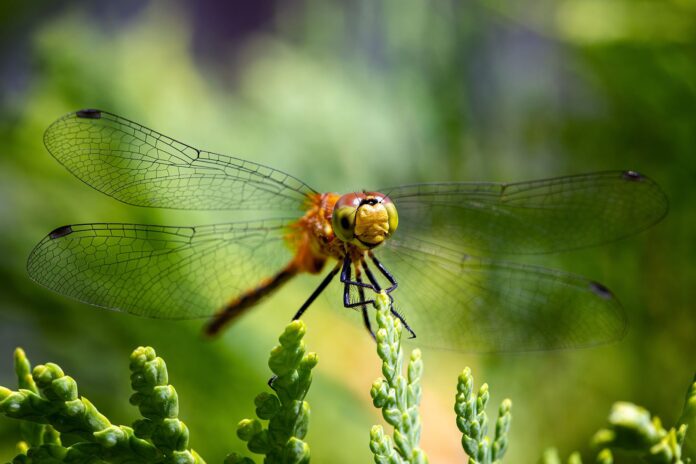A big thank you to avid environmentalist Janice Fisher, a Bolton resident and Caledon Butterflyway Project Ranger, for this great article that reminds us how just a small delay on our part can reap amazing benefits for our natural environment.
Photo (above) credit: Jason Foley
Ah, the longer days, the disappearing snow piles, the sunlight on your face just warm enough to awaken the inner gardener that has been waiting for spring….it is exactly what so many of us have been longing for. We are filled with energy and enthusiasm for our lawns and gardens and are eager to pull out the rakes and trimmers to clean up from our long winter’s nap and fill that yard waste bin to the brim.
But what our native pollinators and other little critters wish we would do is put a pause on that. Our excitement over unearthing spring’s earliest plants pushing up through the dirt sometimes makes us forget that in that pile of leaves or stems from last year’s growth, there may be new life – insects, invertebrates, chrysalides or young tender plants that are not ready to take their chances with unstable temperatures just yet.
 Experts now agree that delaying garden cleanup as long as you can benefits any living thing that is overwintering under the protective coating of decaying stems and leaves. Some will tell you to wait until there are at least 5 days in a row with a daytime high of 10°C before beginning your work. Others will say to wait until you are personally ready to put away your snow shovel and snow boots. If there is still any chance for snow or frost, it is still a bit too early. While some of the early risers, like bumble bees, mining bees, mason bees and carpenter bees, might already be making their first appearances, others like the sweat bees, are still waiting for the warmer temps that May brings. Wait for cherry and apple blossoms to be done and for it to be safe to plant your early veggies.
Experts now agree that delaying garden cleanup as long as you can benefits any living thing that is overwintering under the protective coating of decaying stems and leaves. Some will tell you to wait until there are at least 5 days in a row with a daytime high of 10°C before beginning your work. Others will say to wait until you are personally ready to put away your snow shovel and snow boots. If there is still any chance for snow or frost, it is still a bit too early. While some of the early risers, like bumble bees, mining bees, mason bees and carpenter bees, might already be making their first appearances, others like the sweat bees, are still waiting for the warmer temps that May brings. Wait for cherry and apple blossoms to be done and for it to be safe to plant your early veggies.
So, how to resist the urge to heed the siren song of the first warm sunny days of spring in Ontario?
The Caledon Butterflyway Project encourages you to spend some time planning how and where you can add some beneficial native flowering plants, grasses, shrubs or trees to your yard to join our official Butterflyway and be part of the pollinator pathways that we are just starting our third year creating.
 You might have noticed some of our public plantings: the canoes at the Bolton Firehall on Highway 50 and the Caledon Fire Services building on Old Church Road, the boat at St. John Paul II, or the pollinator garden next to the Albion Bolton branch of the Caledon Public Library. Or maybe you have already jumped on board and have your home pollinator patch listed on the David Suzuki Foundation’s official Butterflyway map.
You might have noticed some of our public plantings: the canoes at the Bolton Firehall on Highway 50 and the Caledon Fire Services building on Old Church Road, the boat at St. John Paul II, or the pollinator garden next to the Albion Bolton branch of the Caledon Public Library. Or maybe you have already jumped on board and have your home pollinator patch listed on the David Suzuki Foundation’s official Butterflyway map.
Have you been out to Albion Hills Farm or the Palgrave Community Kitchen to see how they are saving our native pollinators? Last year Alton and Inglewood both had groups of volunteers come together to plant big pollinator gardens filled with native plants.
We were also very lucky to have had bylaw changes in Caledon in April 2022 that allows for planting on boulevards as long as we plant native wildflowers. I planted mine later in the summer and am thrilled to see early growth in most of the plants.
Why not join the movement? EcoCaledon has graciously invited The Caledon Butterflyway Project to put up a table at the Repair Cafe on April 22 at the Senior Centre. There will be two official Butterflyway Rangers on hand to show you what we have already accomplished and what we hope to achieve this season. Come get some free native seeds and learn how to get more involved.
Read more about the Butterflyway Project in Caledon:
Bolton Woman Among Those Creating Corridors for Pretty Pollinators
Caledon Public Library’s Butterflyway Project Has Taken Flight
Caledon Receives Butterflyway Community Designation
Butterflyway Project Winging Its Way Across Caledon
The post Resisting the Urge to Clean Up Your Lawn appeared first on Just Sayin’ Caledon.



